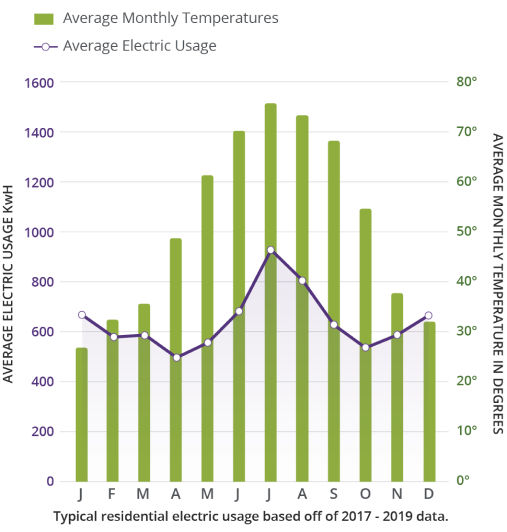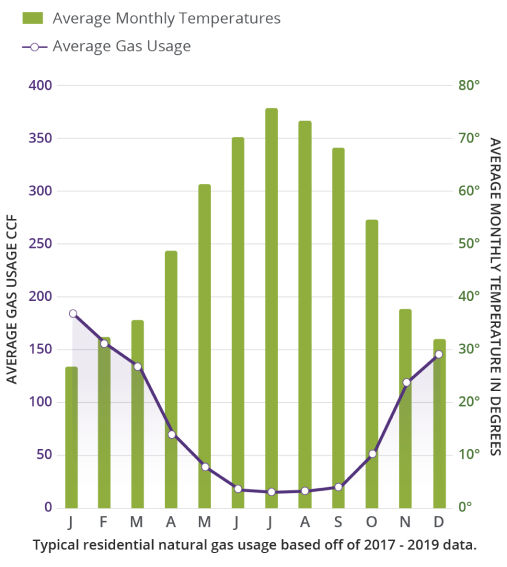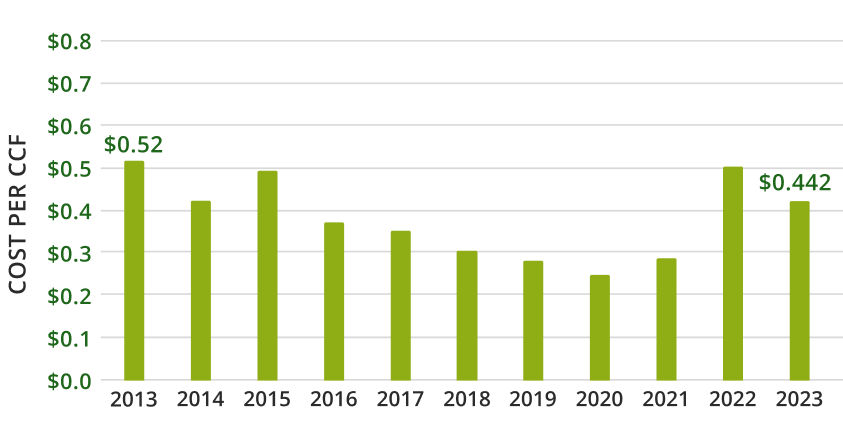Usage & Rates Explained
Your energy use: the more you know, the more you can save.
What makes up your bill each month?
Learn about the ways weather and billing cycles impact your energy bill and how rates are determined. You’ll also find insightful information that will help you:
- Better understand your bill
- Learn more about payment options
- Manage your account
- Save money by reducing energy usage and waste
Weather is a big factor
Just like the seasons change, so do your energy needs. When temperatures rise during the summer, for example, the increase in energy needed to cool your home can increase your energy bills.
This is where energy efficiency comes into play. If you adjust your thermostat 7° to 10° from your normal settings for eight hours each day—regardless of the season—you can save as much as 10% on energy costs over the course of a year!
As temperatures rise and fall, your energy bills will vary.

The above chart demonstrates how changes in the weather impact the amount of energy a typical household uses throughout the year. You’ll notice when average temperatures are at their peak in July and August (98°), energy consumption is also at a high point (800KWh). Conversely, when average temperatures fall during cooler months like April (50°), energy usage is also reduced (600 KWh).
How "Days Billed" affects your monthly payment
Since billing cycles can range from 26 to 35 days, comparing one month’s bill to another may not help you fully understand your usage. For a handy way to evaluate your bills, check out our Understand Your Bill feature. We also offer helpful payment programs such as Flexible Due Date and BudgetWise Billing, which can help you manage your energy payments—and find a payment solution that works best for your budget.
Saving money starts with saving energy
Making energy-saving changes that fit your lifestyle can be easy. Start with simple things, like turning off lights and the TV when no one is in the room and using energy efficient LED light bulbs.
You may also want to consider replacing inefficient appliances. To help you spot and prevent inefficient energy use, visit our wide-ranging Save Money & Energy section, where you can explore our interactive, energy efficient home, get tips and rebate information, download the DTE Insight App to pinpoint possible savings and schedule a free Home Energy Consultation.
How your rates are determined
Your bill reflects the total amount of energy used (kWh), measured by a meter reading at the end of each of your billing cycles. The rates you pay are set by the Michigan Public Service Commission—an independent third party that conducts a public process known as a regulatory rate review. To learn about this process, watch this short video and visit electric rate information in the Quick Links section.
Want to learn more about lowering your energy bills?
Check out our Ways to Save, download the DTE Insight App and visit our Save Money & Energy section.
Quick Links
Fast answers to all your questions
My Usage
Understanding Your Statement
Explanation of Charges
Payment Programs
Payment Assistance Programs
Pricing Options
Get the latest electric rate information
With $1 of electricity, you could
We're always looking to the future
Renewable energy — the new power in Michigan
We recognize our vital role in providing you safe, affordable, reliable and cleaner energy. That’s why we’ve greatly expanded our renewable energy generation portfolio. Today, more of the energy you use comes from wind and solar—and this is only the beginning! Learn more about our commitment to Renewable Energy and discover how you can support clean energy by enrolling in MIGreenPower.
Building strong, smart systems
Our work never ends. In fact, we’re always upgrading and maintaining our plants, substations, poles and wires to safely deliver the energy you count on without interruption. Plus, our advanced technologies help us correct problems before they can affect you. For additional information, please see our Electric Enhancements page.
Usage & Rates Explained
Your energy use: the more you know, the more you can save.
What makes up your bill each month?
Learn about the ways weather and billing cycles impact your natural gas bill and how rates are determined. You’ll also find insightful information that will help you:
- Better understand your bill
- Learn more about payment options
- Manage your account
- Save money by reducing natural gas usage and waste
Weather is a big factor
Just like the seasons change, so do your natural gas needs. During the summer months, for example, it’s likely that your furnace is rarely used, and natural gas consumption is minimal. The opposite is true for the cold months of winter. It’s no surprise that natural gas usage is at a yearly high in January and February—when your furnace is used most often to keep your home warm.
This is where energy efficiency comes into play. If you adjust your thermostat 7° to 10° from your normal settings for eight hours each day—regardless of the season—you can save as much as 10% on energy costs over the course of a year!
Residential Natural Gas Usage Pattern

How "Days Billed" affects your monthly payment
Since billing cycles can range from 26 to 35 days, comparing one month’s bill to another may not help you fully understand your natural gas usage. For a convenient way to evaluate your bills, check out our Understand Your Bill feature. We also offer helpful payment programs such as Flexible Due Date and BudgetWise Billing, which can help you manage your natural gas payments—and find a payment solution that works best for your budget.
What can you do to lower your natural gas bills?
Making natural gas-saving changes that fit your lifestyle can be easy. Start with simple things, like lowering your thermostat a few degrees at bedtime during the colder months and installing low-cost, clear plastic window sheeting over leaking windows to keep cold air out.
To learn more about weatherizing your home, and to help spot and prevent inefficient natural gas use, visit our wide-ranging Save Money & Energy section, where you can explore our interactive, energy efficient home, get tips and schedule a free Home Energy Consultation.
How your rates are determined
Your bill reflects the total amount of natural gas used (Ccf), measured by a meter reading at the end of each of your billing cycles. The rates you pay are set by the Michigan Public Service Commission—an independent third party that conducts a public process known as a regulatory rate review. To learn about this process, watch this short video and visit natural gas rate information in the Quick Links section.
Together, we keep natural gas affordable
The DTE natural gas team’s buying and storage strategy, substantial increases in natural gas supply, and energy-efficiency practices by customers like you have led to big reductions in the average bill. How big? Natural gas bills have fallen by 30 percent over the past 10 years!
We buy natural gas when prices are lowest
DTE purchases natural gas well in advance of winter and stores it until it’s needed. In fact, we utilize underground storage for approximately 50% of the natural gas we need for the colder months. This strategy helps us stabilize the price of natural gas and results in greater reliability of supply for when it’s needed the most. It also lowers the cost we pay for natural gas — which we pass along to customers like you.

Want to learn more about lowering your natural gas bills?
Check out our Ways to Save, and visit our Save Money & Energy section.
Quick Links
Fast answers to all your questions
My Usage
Understanding Your Statement
Explanation of Charges
Payment Programs
Payment Assistance Programs
Pricing Options
Meter Clearing
Natural Gas Safety
Get the latest natural gas rate information
Natural Gas Bill Insert
Natural Gas Rate Card
Natural Gas Rate Book
Natural Gas Choice
We're always looking to the future
Building strong, smart systems
Our work to continually improve our natural gas delivery system never ends. In fact, we’re always monitoring our system, and we make timely repairs and upgrades to keep your service safe, affordable and reliable year-round.
Learn about our natural gas line replacements and other enhancements.
Find your perfect pricing option.
DTE offers pricing options to fit every budget, every lifestyle and every need. Explore all the possibilities and choose the best solution for your household.
- Base Rates. See home electric rate options for Michigan residents.
- Specialty Rate Options. Get special rates based on specific services and equipment in your home.
- Add-Ons. Find even more ways to choose the right energy options for you.